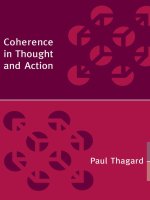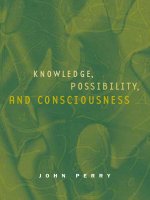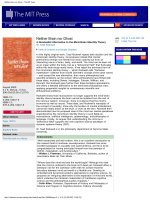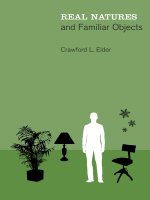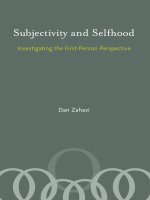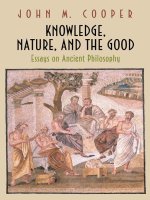the mit press knowledge possibility and consciousness apr 2001
Bạn đang xem bản rút gọn của tài liệu. Xem và tải ngay bản đầy đủ của tài liệu tại đây (634.63 KB, 238 trang )
KNOWLEDGE,
POSSIBILITY,
AND CONSCIOUSNESS
JOHN PERRY
Physicalism is the idea that if everything that goes
on in the universe is physical, our consciousness
and feelings must also be physical. Ever since
Descartes formulated the mind-body problem, a
long line of philosophers has found the physicalist
view to be preposterous. According to John Perry,
the history of the mind-body problem is, in part,
the slow victory of physical monism over various
forms of dualism. Each new version of dualism
claims that surely something more is going on with
us than the merely physical.
In this book Perry defends a view that he calls
antecedent physicalism. He takes on each of three
major arguments against physicalism, showing
that they pose no threat to antecedent physical-
ism. These arguments are the zombie argument
(that there is a possible world inhabited by beings
that are physically indiscernible from us but not
conscious), the knowledge argument (that we can
know facts about our own feelings that are not
just physical facts, thereby proving physicalism
false), and the modal argument (that the identity
of sensation and brain state is contingent, but
since there is no such thing as contingent identity,
sensations are not brain states).
John Perry is the H. W. Stuart Professor of Philosophy
at Stanford University.
Jean Nicod Lectures
A Bradford Book
“Wit is surpassed only by acumen in this
pithy book. Chief objections to physicalism
are stated lucidly, and rebutted convincingly.
The field is enlivened and even readers who
demur will reap.”
— Ernest Sosa, Brown University
and Rutgers University
Massachusetts Institute of Technology
Cambridge, Massachusetts 02142
http:/mitpress.mit.edu
KNOWLEDGE,
POSSIBILITY,
AND CONSCIOUSNESS
KNOWLEDGE, POSSIBILITY, AND CONSCIOUSNESS
PERRY
The MIT Press
Cover Image: © 2000 PhotoDisc, Inc. Jacket Design: Patrick Ciano
PERKH 0-262-16199-0
,!7IA2G2-bgbjjc!:t;K;k;K;k
JOHN PERRY
Knowledge, Possibility,
and Consciousness
The Jean Nicod Lectures
Fran¸cois Recanati, editor
The Elm and the Expert: Mentalese and Its Semantics, Jerry A.
Fodor (1994)
Naturalizing the Mind, Fred Dretske (1995)
Strong Feelings: Emotion, Addiction, and Human Behavior, Jon
Elster (1999)
Knowledge, Possibility, and Consciousness, John Perry (2001)
The 1999 Jean Nicod
Lectures
Knowledge, Possibility,
and Consciousness
John Perry
The MIT Press
Cambridge, Massachusetts
London, England
© 2001 Massachusetts Institute of Technology
All rights reserved. No part of this book may be reproduced in any form by
any electronic or mechanical means (including photocopying, recording, or
information storage and retrieval) without permission in writing from the
publisher.
This book was set in Palatino by Windfall Software using ZzT
E
X and was
printed and bound in the United States of America.
Library of Congress Cataloging-in-Publication Data
Perry, John, 1943–
Knowledge, possibility, and consciousness / John Perry.
p. cm. — (The Jean Nicod lectures ; 1999)
Includes bibliographical references and index.
ISBN 0-262-16199-0 (alk. paper)
1. Knowledge, Theory of. I. Title. II. Series.
BD161 .P43 2001
128'.2—dc21 00-048959
To the memory of my brother
Tom Perry
1941–1998
Contents
Series Foreword xi
Preface xiii
1 Experience and Neo-Dualism 1
1.1 The Experience Gap Argument 2
1.2 The Dialectic of Identity 4
1.3 The Zombie Argument 10
1.4 The Knowledge Argument 15
1.5 The Modal Argument 16
1.6 The Plan 18
2 Sentience and Thought 25
2.1 Antecedent Physicalism 26
2.2 Physicalism and Materialism 29
2.3 Common Sense about the Mind 30
2.4 The Metaphysics of Mental States 37
3 Thoughts about Sensations 45
3.1 Having and Knowing 46
3.2 The Epistemology of Experience 50
3.3 Mental States as Physical States 62
3.4 Doctrines Physicalism Must Avoid 67
viii Contents
4 The Zombie Argument 71
4.1 Why Zombies Could Not Be Physically Like Us 72
4.2 Dualism and Epiphenomenalism 77
4.3 Supervenience and Epiphenomenalism 80
4.4 The Inverted Spectrum 89
5 The Knowledge Argument 93
5.1 Mary and the Black and White Room 94
5.2 Locating the Problem 95
5.3 Raising Suspicions 101
5.4 The Subject Matter Assumption 113
6 Recognition and Identification 117
6.1 A Case of Recognition 119
6.2 Reflexive Contents 122
6.3 The Search for Recognitional Knowledge 132
6.4 Information Games 135
6.5 Recognizing Universals 139
6.6 Recognition and Necessary Truth 143
7 What Mary Learned 145
7.1 Mary’s New Knowledge 145
7.2 What Mary Remembers 150
7.3 Recognitional Knowledge and Know-How 152
7.4 Lewis and Eliminating Possibilities 159
7.5 Churchland’s Challenge 163
8 The Modal Argument 169
8.1 Contents and Possibilities 170
8.2 Kripke’s Argument 178
8.3 Chalmers’ Argument 188
8.4 Ewing’s Intuition 202
Contents ix
Notes 209
References 213
Index 219
Series Foreword
The Jean Nicod Lectures are delivered annually in Paris by
a leading philosopher of mind or philosophically oriented
cognitive scientist. The 1993 inaugural lectures marked the
centenary of the birth of the French philosopher and logician
Jean Nicod (1893–1931). The lectures are sponsored by the
Centre National de la Recherche Scientifique (CNRS) as part
of its effort to develop the interdisciplinary field of cognitive
science in France. The series hosts the texts of the lectures or
the monographs they inspire.
Jacques Bouveresse, President of the Jean Nicod Committee
Andr´e Holley, Director of the Cognitive Science Program,
CNRS
Fran¸cois Recanati, Secretary of the Jean Nicod Committee
and Editor of the Series
Jean Nicod Committee
Mario Borillo
Jean-Pierre Changeux
Jean-Gabriel Ganascia
Michel Imbert
xii Series Foreword
Peirre Jacob
Jacques Mehler
Philippe de Rouilhan
Dan Sperber
Preface
This book is based on the Nicod lectures given in Lyon and
Paris in June 1999. I am very thankful to the Centre Na-
tional de la Recherche Scientifique (CNRS) and the Nicod
Lecture Committee for selecting me, and to Jacques Bouver-
esse, Andr´e Holley, Pierre Jacob, Fran¸cois Recanati, Daniel
Andler, Jo¨elle Proust, Jerome Dokic, Jerome Pelletier, and
other French philosophers and cognitive scientists for the
hospitality they showed me. The Centre de Recherche en
Epist´emologie Appliqu´ee (CREA) and Maison Suger were
fine hosts.
The central ideas of this book were presented earlier at the
Chapel Hill Philosophy Colloquium in 1998 and at colloquia
at various universities. They have been shaped over many
years, with many influences, for better or worse. I remem-
ber being interested in the problems discussed in this book
while I was an undergraduate at Doane College. I had a job
delivering appliances throughout a wide area of southeast-
ern Nebraska, and as I drove the Wanek’s Furniture truck
across the countryside I tried to keep my mind on Wittgen-
stein’s arguments about beetles and boxes. I had the feeling
that if I was bright enough, and tried hard enough, the trou-
blesome beetle in my box would be revealed as a bit of con-
ceptual confusion and disappear. Thank goodness it never
xiv Preface
did. Laurence Nemirow rekindled my interest in these prob-
lems when I had the good luck to work with him on his
dissertation at Stanford in the late 1970s. Although in chap-
ter 7 I disagree with part of Nemirow’s analysis, his ideas
and particularly the emphasis he put on the role of imagi-
nation in our concepts of sensory states greatly influenced
me. Many years later, G ¨uven G¨uzeldere came to Stanford
and raised everyone’s consciousness about consciousness.
My Nicod lectures, like Fred Dretske’s before them, owed
a great deal to G¨uzeldere. In particular G¨uzeldere encour-
aged me to give a talk at an American Philosophical Asso-
ciation symposium on my first rather inchoate ideas about
how work on indexicals and reflexivity might be relevant to
the knowledge argument. We discussed all aspects of the ar-
gument and qualia at great length while he worked on his
dissertation at Stanford. He was a superb student and a su-
perb teacher. At about the same time G¨uven was at Stanford,
Lydia Sanchez was working on her dissertation, which em-
phasized issues related to the subject matter doctrine and
problems of unreflected identity. Talking these issues over
with Lydia was very helpful
After the first draft of this book was completed, I received
helpful comments from a number of philosophers, includ-
ing G¨uzeldere, Ned Block, Eros Corazza, Chuck Marks, John
Fischer, Carlo Penco, David Barnett, Matthew Barrett, and
Tim Schroeder. Robert C. Jones made a very clear and per-
suasive presentation of the draft to the Pat Suppes–Dagfinn
Follesdal seminar on consciousness at Stanford. I had the
wonderful opportunity to attend the Ned Block–Tom Nagel
seminar at New York University during a session on the
draft of my book. Listening to Nagel and Block disagree
about what I should have said or meant was particularly
instructive. These comments and interactions led to a new
version of the last chapter and a number of changes in ear-
Preface xv
lier chapters. Matthew Barrett’s comments convinced me I
ought to have more to say than I do about the problem of
other minds, especially the minds Martians might have. But
I haven’t yet figured out what to say, except that I can’t see
that neo-dualism would help. Parts of the draft were used in
my freshman seminars on consciousness; the students’ reac-
tions and comments were quite helpful. Rebecca Talbott kept
me from making a serious error in chapter 5.
The Nicod lectures and the final rewrite of the book were
both completed in Bonn, Germany, where I spent the spring
quarters of 1999 and 2000. This was made possible by a
prize from the Humboldt Foundation. These stays were re-
warding and productive thanks to the hospitality of Ranier
Stuhlmann-Laeisz and the other members of the Insitute f¨ur
Logic und Grundlagenforschung at the University of Bonn;
I especially thank Albert Newen for his support and friend-
ship.
I owe a considerable debt to the philosophers I discuss
in this book. Giving a seminar on David Chalmers’ excit-
ing and absorbing book, The Conscious Mind, was especially
helpful; it is full of ideas and arguments that clarified a num-
ber of things for me, even while I continued to disagree
with the central thesis. A number of authors whom I do
not discuss—David Rosenthal, John Searle, Daniel Dennett,
and Patricia Churchland, to mention just four who represent
a broad spectrum of approaches—have also influenced my
ideas a great deal, even though I don’t fully understand at
this point how all of the insights can be fit together.
I am dedicating this book to my late brother Tom. We
loved to discuss and argue about all sorts of things, in-
cluding philosophy. Tom was full of interesting ideas and
was imaginative and passionate about all sorts of issues. He
wrote and enjoyed science fiction, and I suspect he thought
philosophy was basically a way of thinking about the same
xvi Preface
issues without having nearly so much fun. Writing science
fiction was a hobby on which he hoped to focus when he re-
tired, but sadly cancer cut that dream short. He spent most
of his career with IBM, first as a technical writer, then as a
computer scientist, working on a variety of platforms from
the 1960s into the 1990s. I’m sure that some of his ideas and
inventions are at work inside my computer as I write this.
When we were both in our early teenage years Tom came
up with the theory that there was only one soul in the uni-
verse, which traveled backward in time each time a person
died and was recycled as some other person’s soul. That was
the first time I tried hard to think of reasons against a philo-
sophical theory. I didn’t come up with any objections that he
couldn’t shoot down. Finally he convinced me this was the
most minimal and economical form of dualism, a perfect ex-
ample of Occam’s Razor. We had a lot of fun figuring out
how this theory would work. So Tom was the first to bring
up the challenge of dualism, not to mention personal iden-
tity. As I’ve mentioned elsewhere, Tom, who was a couple
of years older, once told me he would “give me ten dollars
tomorrow.” This repeated promise amused him for a couple
of days and gave rise to my interest in indexicality.
I don’t suppose Tom stuck with his one-soul theory, but he
certainly would have sided with Leibniz, Ewing, Chalmers,
Jackson, and Kripke on the issues I discuss in this book. He
thought physicalism was pretty dumb. As a computer sci-
entist, he was particularly scornful of theories that held that
the human mind was anything like a computer. It’s some-
what odd to dedicate my defense of physicalism to him, but
these are the only views I have to offer.
1
Experience and
Neo-Dualism
. . . the terms “subjective” and “private” inoneoftheir commonly
proper and serviceable usages are not to be considered as logically incom-
patible with “objective” or “public.” Private states in this philosoph-
ically quite innocuous sense are then simply central states.
—Herbert Feigl, The “Mental” and The “Physical”: The Essay and a
Postscript
One way to explain my goal in this little book is to say that I
am trying to defend the philosophical coherence of the 1966
Academy Award winning movie Fantastic Voyage (Fleischer
1966). In this movie, a very important person has a brain clot,
and since it would be a disaster if this person’s brain were
damaged in any way, because he knows something very im-
portant, the government decides to shrink a team of neuro-
surgeons until they are extremely small, put them in a very
tiny submarine, and inject them into the bloodstream of the
very important person. They make their way to the blood
clot, destroy it with their miniature laser guns, and, after
many adventures, including the destruction of their subma-
rine, wade their way to safety, leaving the body through a
tear duct. It is not the philosophical coherence of the main
2 Chapter 1
plot of the movie that I wish to defend. It is simply one re-
mark that a member of the rescue team makes while they are
mid-brain. A sort of beautiful blue vapor arises from a cer-
tain part of the brain, capturing the attention of the rescuers.
Awestruck, Arthur Kennedy says to Raquel Welch, “Look,
we are the first to actually see human thoughts,” or words
to that effect. No one in the boat finds this the least bit odd.
1.1 The Experience Gap Argument
The episode in Fantastic Voyage assumes that it is conceiv-
able that one might observe, using one’s physical senses, a
thought or experience of another. This is a natural view to
have, if one thinks, as I do, that our thoughts and experi-
ences are events in our brains. A long and a quite distin-
guished philosophical tradition finds this view preposter-
ous. Leibniz invited us to imagine that the brain was en-
larged to the size of a flour mill, so we could walk inside
and see all that was happening. It is obvious, he said, that we
would not see anything like a thought or experience (Leibniz
1714). A couple of centuries later, British philosopher A. C.
Ewing put the point like this:
Nineteenth-century materialists were inclined to identify think-
ing, and mental events generally, with processes in the central ner-
vous system or brain. In order to refute such views I shall suggest
your trying an experiment. Heat a piece of iron red-hot, then put
your hand on it, and note carefully what you feel. You will have
no difficulty in observing that it is quite different from anything
which a physiologist could observe, [when] he considered your
brain processes. The throb of pain experienced will not be like
anything described in textbooks of physiology as happening in the
nervous system or brain. I do not say that it does not happen in the
brain, but it is quite distinct from anything that other people could
observe if they looked into your brain Weknow by experience
Experience and Neo-Dualism 3
what feeling pain is like and we know by experience what the phys-
iological reactions to it are, and the two are totally unlike the
difference is as plainly marked and as much an empirical matter as
that between a sight and a sound. The physiological and the mental
characteristics may conceivably belong to the same substance
but at least they are different in qualities, indeed as different in kind
as any two sets of qualities. (Ewing 1962, 110)
In thinking about Ewing’s point, I imagine talking to this
distinguished philosopher, a fellow of the British Academy
and a lecturer at Cambridge, in my backyard in California.
“Grab a red-hot coal from your charcoal grill!” he challenges
me. “Hold it in your hand and observe carefully the searing
unendurable pain that arises in your consciousness. Does
that seem anything like a brain state?” I am so sure that he
has the empirical facts right that I grant his premises without
even performing the experiment. Leibniz and Ewing draw
forcefully to our attention the fact that having an experience
is quite unlike what one supposes perceiving a brain state or
process would be like; they conclude that experiences and
thoughts are not brain states or processes. Can we grant the
premise but avoid the conclusion?
If we imagine following Ewing’s directions, it goes some-
thing like this. We are feeling an intense pain. We focus on
that pain and on a certain aspect of it. Not on its cause, nor
on the injury it might lead to, but on what it is like to have it.
This aspect of the experience is sometimes called its “subjec-
tive character,” and such aspects are sometimes called “qua-
lia.” We focus on this aspect of the pain, and as we focus on it
we think, “This feeling is ”Then we imagine filling in the
right-hand side of this identity with any way we can imagine
apprehending a brain state. Perhaps we imagine seeing the
inside of a brain, as in Fantastic Voyage: or we imagine having
Herbert Feigl’s imaginary instrument, the autocerebroscope,
4 Chapter 1
which allows one to examine one’s own brain while using it
(Feigl 1967). We focus on a certain state presented to us in
one of these ways and think of it as “that brain state.” So
we think, “This feeling is that brain state.” And this strikes
us, according to Ewing, as perfectly absurd. Or perhaps we
imagine identifying the brain state in some less direct but
more probable way, as for example as the state the onset of
which corresponds to a sudden blip on the monitor of an in-
strument. Or perhaps we imagine a label or description of a
brain state that we have read about in books or studied in
classes: the brain state so-and-so. It will strike us as absurd,
according to Ewing, that our thought or supposition, “This
feeling is the brain state so-and-so,” could be true.
The absurdity will derive from how much the properties
we notice—the subjective characters of our experience—
differ from the ones that we imagine seeing or reading
about. To say that this, the feeling I am aware of when I,
so to speak, look inward, is that, the thing I read about, just
seems crazy. This feeling is what I will call the “Ewing in-
tuition,” and the argument based on it, the “experience gap
argument”: this could not be a brain state, because the gap be-
tween what it is like and what brain states are like is simply
too large.
1.2 The Dialectic of Identity
A modern philosopher might pause before giving into the
Ewing intuition and the experience gap argument, for at
least three reasons. First, of course, is the wide acceptance
of various forms of physicalism. If everything that goes on
in the universe is physical, then my consciousness must be
physical, and this feeling must be physical, however odd
that may seem. And many smart people think that every-
Experience and Neo-Dualism 5
thing that goes on in the universe is physical. One really
ought to hesitate, just on general principles, before rejecting
this doctrine.
In addition to this somewhat ideological doubt, two re-
lated technical problems about the argument will imme-
diately strike a philosopher. The first is that the candidate
thought is an identity, and Frege has taught us all that iden-
tity gives rise to difficult problems (Frege 1960). Frege was
particularly interested in what it is that informative iden-
tity statements convey. If the statement “This sensation is
that brain state” is true, it is just such an informative iden-
tity statement—not only informative, but at least according
to Ewing and Leibniz, absolutely astounding. Philosophers
know that the minority of their number who have thought
long and hard about the difference between “Tully is Tully”
and “Tully is Cicero” have yet to reach agreement on the
right thing to say, and that the pages and passions devoted
to this problem by analytical philosophers in the twentieth
century compare to those devoted to the many problems one
might have thought to be both more important and more
difficult, like, for example, the existence of God, the basis
of personal identity, or the nature of virtue. Philosophers
naturally hesitate before accepting any argument, however
strong its intuitive pull, that turns on rejecting an identity
statement. And of course in this particular case at least one
part of the informative identity statement involves a demon-
strative, “this feeling.” Demonstratives and indexicals pro-
vide additional puzzles.
Second, not only identity statements, but also the relation
of identity itself, presents problems. Identity is simply that
relation an object has to itself and to no other; it is the rela-
tion that holds between a and b when there is just one thing
that is both a and b.Ifa and b are identical, then they must
6 Chapter 1
share properties, for there is only one thing whose properties
are at issue. It seems then that it is a small matter to prove
nonidentity; one simply finds a property a has and b does not
to show that a is not b. This is just the strategy a defense at-
torney might follow to show that the defendant was not the
criminal. If the attorney can place the defendant in Toledo,
say, at a time when the criminal had to be in Dubuque, she
should win the case.
At first glance, this makes things look pretty good for the
Ewing intuition. The properties that we find in the state of
which we are subjectively aware, the feeling of pain, seem
quite different than the ones associated with any brain states
identified physically. The brain state will involve certain
parts of the brain, for example, whereas my feeling of pain
seems to be located in my hand insofar as it has a bodily lo-
cation. The pain is quite intense and unpleasant. But what
would make a brain state intense or unpleasant?
At second glance there is a problem, however. It is not
enough to show that the properties we discover about a,
thought about in one way, are quite different than those we
associate with b, thought about in another way. We must
show that a clearly lacks a property b has. Somewhat para-
doxically, the more unlike a and b seem to be at first glance,
the harder this may be to show. In particular, one has to keep
in mind a fact that seems at first quite odd. Although the
truth of the statement “a =b” requires something pretty im-
portant of a and b, it doesn’t require much of anything about
“a” and “b,” other than that there is a single thing to which
they both refer. “a” does not need to be definable in terms of
“b,” or to have been introduced in terms of “b,” or to involve
properties that supervene on those that “b” involves, or vice
versa. In this sense, identity is a very weak relation.
Experience and Neo-Dualism 7
Consider, for example, claims that one individual, exist-
ing at one time, is the reincarnation of what appears to be
another individual, living at another time. The present Dalai
Lama, for example, is claimed to be the reincarnation of the
previous Dalai Lama, who died some years before the cur-
rent one was born. Reincarnation is supposed to be a matter
of being the same person, the same consciousness, surviving
in a different body. Suppose one says, “Well, the fourteenth
Dalai Lama is clearly not the thirteenth Dalai Lama, since
the thirteenth had many properties the fourteenth does not
have. The thirteenth is dead, was born in the nineteenth cen-
tury, and lived in Tibet his whole life; the fourteenth is alive,
was born in the twentieth century, and has lived in China
and India as well as in Tibet.” To this it can be easily replied,
“The fourteenth was also born in the nineteenth century,
born then in his previous incarnation. The thirteenth has
also lived in India; he has been living there in his present
incarnation.” Once one accepts the possibility of reincarna-
tion, then one naturally makes some logical distinctions and
adds parameters to various empirical predicates. A person
lives a certain time in a certain body; a person is born at a
given time in a given incarnation; a person dies in one incarna-
tion but is born in another, and so forth. Instead of a number
of properties that the thirteenth Dalai Lama has and the four-
teenth does not, we find more complicated conditions that
both Dalai Lamas share, the apparent differences residing in
the parameters associated with two different ways of think-
ing of the same object. “The fourteenth Dalai Lama” is a way
of thinking of the Dalai Lama via his present reincarnation,
“the thirteenth Dalai Lama” a way of thinking of him via his
previous incarnation. We may doubt that looking at things in
this way is right, but it is hard to argue that it is inconsistent.
The fourteenth Dalai Lama, energetic, robust, and living in
8 Chapter 1
India, strikes us as being quite different, in innumerable
ways, from the thirteenth Dalai Lama, a lifelong resident
of Tibet, long dead. But a simple appeal to the logic of iden-
tity and the properties the Dalai Lamas were observed to
have will not suffice to dispose of a doctrine defended by
subtle distinctions and explanations accumulated over the
centuries of Tibetan Buddhism. One needs to argue the case
on more substantive grounds involving the nature of per-
sonal identity, what would be required for reincarnation,
and the physical basis of memory.
Ewing’s statement that the conscious and the physical are
as different as sight and sound suggests another more rele-
vant example. Molyneaux posed a famous problem to John
Locke: if a blind man were suddenly able to see, could he
tell, merely by looking, before any experience of correlation,
that when he looked at a sphere, he was seeing the same
shape with which he was familiar by touch? Locke agreed
with Molyneaux’s conjecture that he could not. That is, the
truth of the thought, “This (seen) shape is this (felt) shape,”
would be a surprising but true identity. What could be more
unlike than vision and touch (Locke 1694: bk. I, chap. IX)?
But the analogy is imperfect in an important way. In the
Molyneaux case we have one property or state of a physical
object: sphericity. And we have two sensations, quite unlike.
The sensations are not one and the same; it is what they
are sensations of that is one and the same. Suppose Arthur
and Raquel are in my brain having visual sensations of the
various things going on there. I have the sensation of pain.
The question is not whether their visual sensations and my
pain sensation are sensations of the same thing. It is rather
whether my sensation itself, the pain, is that state, property,
or process that their visual sensations are of. Is the pain I
have the brain state they observe?
